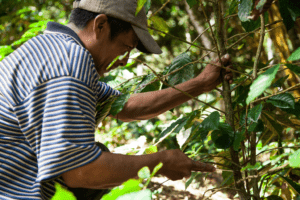An espresso: 20–30 ml of delicious coffee. It takes just minutes to drink it. But it takes years to produce it. From carefully selecting and planting the coffee tree through to harvesting, processing, and drying the beans, a producer’s work never stops.
But how do producers decide which coffee to grow? How do they harvest it? What’s involved in processing and drying?

CHOOSING THE RIGHT COFFEE TO GROW
There’s more than one type of coffee. Some varieties produce high-quality beans but are susceptible to disease. Others are hardier. Some yield more coffee than others, some are sweeter, and some suit certain types of soil.
So, how does a producer choose which coffee they grow?
ICFC Panama biologist and coffee value chain analyst Valentina Pedrotti says it varies from country to country. The climate and local culture often decide a producer’s choice. Many simply grow what is common in that area or what has always been farmed on that land.
But the soil, altitude, humidity, and other climatic features have an impact on the flavor of the final coffee, so it’s important to choose wisely. Other considerations include the cost and expected market value of the beans, and if diseases and pests are an issue
And availability is a constant limitation. Take F1 hybrids, such as Starmaya. It’s high-quality, high-yield, and highly resistant to disease – the ideal coffee plant, in other words. Yet it’s a new variety and only a handful of producers currently have access to it.
With all these things to consider, it can be hard to choose the best variety. Arturo Aguirre of the award-winning Finca El Injerto in Guatemala says that it’s important producers understand their land. “You have to know where your farm is really well.” The location and soil are deciding factors on whether certain varieties will thrive.

PLANTING THE SEED
Тохиромжтой сортыг сонгосны дараа тариалах ажил эхэлнэ. Мэргэжилтнүүдийн дүгнэснээр кофены тариалалтын эхний үе шат буюу үрсэлгээ болон суулгацын шатанд ургамалд нөлөөлдөг хамгийн чухал хүчин зүйл нь орчны температур ажээ. Жишээлбэл Арабика сортын кофе нь Цельсийн 18-21 хэмд нэн тохиромжтой бөгөөд үүнээс халуун нөхцөлд таагүй өөрчлөлт үзүүлж эхэлдэг.
Alvarez explains that he starts with a seedbed filled with treated sand to stimulate germination and initial growth, as well as prevent disease. The coffee seeds stay in the seedbed for 70 days. Next, he transplants the seedlings to individual bags filled with an earthy, fertile soil mix. The young plants stay in this nursery for anywhere between seven months to a full year. He covers them with plastic wrap to control the amount of light. At this stage, it is essential that the main root grows vertically to provide stability and allow the coffee plant to live longer.


CARING FOR THE COFFEE PLANT
Alvarez stresses that before setting up the farm with young plants, it’s important to decide how densely the trees should be planted. The producer will decide this based on how they intend to prune and stump the plants later on. They will also consider how the plants will be harvested and the individual features of the variety.
Upkeep is needed for coffee plants to last and for production to be consistent. It’s important to prune, or trim, the producing branches and main vertical trunks after each harvest.
The plant should also be regularly stumped to ensure a good yield. This means that each plant is cut to 30–40 cm from the bottom to allow new growth. How frequently this needs to be done depends on many factors, including planting density and the amount of shade. Stumped plants won’t yield fruit until they regrow, so it’s important to divide the farm into lots and stagger stumping them.
Producers may also need to consider completely re-planting certain lots on their farm after the trees reach a certain age.

Coffee plant nutrition happens at the leaf and root, and neither should be neglected. Alvarez says that it is extremely important to take care of the soil and keep up with fertilizer schedules to give plants the nutrition they need.
During the rainy season, undergrowth maintenance will help prevent diseases developing. At other times of the year, producers need to watch out for coffee leaf rust, or la roya. This fungal infection is extremely common and can devastate crops by damaging the leaves, which are necessary for converting sunlight into energy. In other words, without the leaves, the plant cannot survive.
FROM FARM TO CUP
Every year, after the rainy season, the trees will flower. The delicate white blooms, with their sweet aromas, are more than just a pretty sight, though. They are important for coffee cherry growth.
With Arabica coffee, there is a nine-month waiting period between the flowering and the coffee harvest. But this isn’t a rest period. The producer must regularly inspect the developing cherries to make sure that they’re ripening at the correct time, as well as check for pests.
And don’t underestimate the difficulty of the harvest. Cherry picking is a long and difficult task, especially when quality-oriented producers are looking for perfectly ripe cherries. Sorting the harvest is also important – and time-consuming. Even a few low-quality or defective beans can reduce the quality of an otherwise excellent lot.
After the cherries have been are harvested, they need to be processed. This means removing the coffee beans from the cherries and then drying them.
Processing can be done in many ways, but there are three main methods:
- Natural: Beans are dried in their cherries, adding sweetness and fruity notes to the coffee. Consistency can be harder to achieve.
- Washed: Beans are removed from the cherries and fermented in water before being dried, resulting in a clean and consistent profile. It requires more equipment than natural processing.
- Honey/pulped natural: Part of the fruit is removed, with a certain degree of mucilage left on the beans during drying. The more mucilage, the sweeter and fuller-bodied the coffee – but the greater the effort and risk involved.

Aguirre says, “It is very hard to grow coffee. Not only is the producer fighting nature’s adversities, but a cup of coffee requires a lot of work, a ton of people… That is the real value of coffee.”
